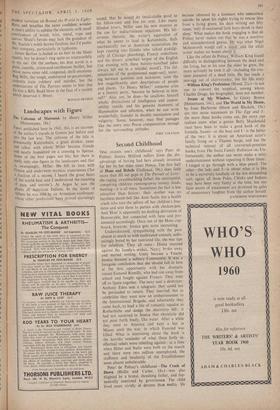Landscapes with Figure
.The Colossus of Maroussi. by Henry Miller. (Heinemann, 18s.) FIRST published here in 1942, this is an account !If the author's travels in Greece just before and into the last war. The colossus of the title is Presumably Katsimbalis, a great drinker, eater and talker with whom Miller became friends and nearly foundered on a crossing to Spetsai. Some of the best pages are his; but there is really only one figure in the landscapes and that is, swampingly, Miller. He fell in love with Greece and underwent mystical experiences ('for a fraction of a second I heard the great heart of the world beat and I understood the meaning of pain and sorrow'). At Argos he saw the ghosts of American Indians. In the slums of Athens he was told by an Armenian soothsayer, whose other predictions have proved alarmingly
sound, that he would do incalculable good to his fellow-men and live for ever. Like many blinded lovers, Miller uses his new mistress as the cue for indiscriminate rejections. His hit- or-miss rhetoric, the writer's equivalent of what he seems to laud in Katsimbalis, flails mechanically out at American materialism (he kept running into Greeks who talked nostalgi- cally of Chicago plumbing), French orderliness and the dreary, armchair torpor of the English ('an evening with these buttery-mouthed jakes always left me in a suicidal mood'). The ful- minations of the professional super-naif, teeter- ing between quietism and hedonism, taint the few magnificently alert descriptions of people and places. 'To Henry Miller!' someone cries at a literary party, 'because he believes in him- self!' Alas, yes, he does—he swallows himself whole; distinctions of intelligence and respon- sibility vanish, and his genuine moments of illumination and affection, when he can write wonderfully, founder in shoddy messianism and vulgarity. Some, however, may find passages like the entry into Poros compensation enough for the surrounding attitudes.
JOHN COLEMAN


































 Previous page
Previous page